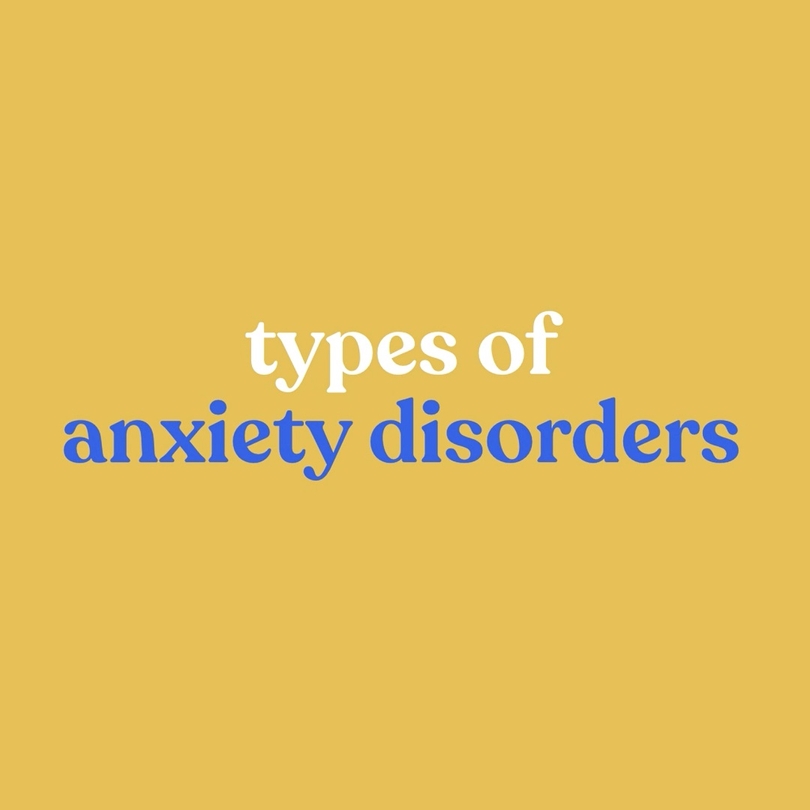What are the types of anxiety
Some types of anxiety can be easy to identify, other types can be difficult to distinguish from the normal ups and downs we all go through.

Dr Aneta Kotevski
October 13, 2022
6 min read
#anxiety

In part 3 of our series on anxiety you will learn to recognise the different types of anxiety and how they may be affecting your daily life.
Understanding the different types of anxiety
There are several different types of anxiety, which can impact on daily life in different ways. Living with anxiety can be challenging and isolating. Some types of anxiety can be easy to identify, other types can be difficult to distinguish from the normal ups and downs we all go through.
It's more common than you think
When you are affected by a psychological disorder, this can cover a range of illnesses, which includes anxiety. The National Study of Mental Health and Wellbeing found that an estimated 1 in 5 Australians aged 16–85 will experience a psychological disorder in a 12-month period [1].
Anxiety is the most common type of condition reported.
What types of anxiety are there
Anxiety can be generally understood as excessive, stress, or worry about something. The type of anxiety you may be experiencing can be better understood by looking at what they stress or worry is related to, and how it impacts us or changes our behaviour.
Generalised Anxiety Disorder (GAD)
This is characterised by excessive anxiety and worry, occurring on most days over a period of a number of months. It can occur at home, and in public settings such as work or school settings. The worry is difficult to control.
Generalised Anxiety Disorder is usually associated with symptoms like restlessness, feeling keyed up or on edge, fatigue, difficulty concentrating, irritability muscle tension and sleep problems (difficulty falling or staying asleep, or restless, unsatisfying sleep). Generalised Anxiety Disorder can be distressing to experience and often negatively affects a person's ability to engage properly in social, work, and family or relationship situations.
Panic Disorder
Panic is characterised by an intense episode of fear or discomfort, which occurs suddenly and reaches a peak within minutes.
Panic attacks associated with a panic disorder can occur repeatedly and ‘out of the blue’ with no apparent trigger.
During a panic attack you may experience heart palpitations, sweating, trembling, or shaking, shortness of breath, chest pain or discomfort, nausea, dizziness, numbness and fear of losing control.
Social Anxiety Disorder
This is a persistent fear of one or more social or performance situations. This may be situations in which the person is exposed to unfamiliar people, like attending a new school, going to a party, etc. Social anxiety disorder can also be triggered by situations where there is possible scrutiny by others, like in a public speaking situation.
Exposure to the feared social or performance situation almost invariably provokes anxiety, and avoidance. People suffering from social anxiety disorder usually recognise that the fear is unreasonable and disproportionate to the actual threat.
People with social anxiety disorder commonly fear that they will act in a way that will be humiliating or embarrassing when in social situations. This can include fear that they will show symptoms of their anxiety. This is one of the many ways that anxiety can be cyclic, where fear of the anxiety adds to the anxiety. We are going to explore this topic in more detail in a future article.
Obsessive Compulsive Disorder (OCD)
This condition is where a person is experiencing recurring or repetitive symptoms:
-
Recurrent and persistent thoughts, images or urges, known as obsessions, which are unwanted and cause people significant anxiety or emotional distress
-
The need to carry out certain repetitive behaviours, rituals, or mental acts, known as compulsions, to ignore, suppress or neutralise such compulsions, and to reduce anxiety. The symptoms of obsessive compulsive disorder (OCD) are often distressing to the person experiencing them, and can lead to people avoiding situations which trigger their OCD thoughts or behaviours.
Some common obsessive thoughts include:
-
Fear of contamination from dirt or germs
-
Overwhelming concern with personal safety or the safety of others
-
Needing objects to be organised in a certain way all the time
-
Thoughts inconsistent with a person's values, such as aggressive, sexual, or blasphemous thoughts.
Some common compulsive behaviours include excessive or repeated:
-
Cleaning, for example, washing hands or scrubbing household surfaces
-
Repeated checking, for example, whether doors are locked or appliances are switched off
-
Ordering, for example, placing objects in a particular pattern or making things look symmetrical
-
Mental acts, for example, reciting phrases in one's head or counting
-
Hoarding, for example, collecting old newspapers or other things that aren't useful or of value.
Specific Phobia
A phobia involves an unreasonable fear of certain objects or situations, which leads to anxiety and distress and is disproportionate to the threat present. Common specific phobias include fears of flying, excessive fear of spiders and other animals, fear of receiving injections.
Post-Traumatic Stress Disorder (PTSD)
In our lifetime, we are likely to experience at least one traumatic life event. Whilst most people recover from these events, some trauma can overwhelm our ability to cope. Serious trauma can diminish our ability to self-regulate emotions. This can lead to intense feelings of helplessness, and possibly eventuate in post-traumatic stress disorder (PTSD).
Emotional signs of PTSD include fear, anger, denial, and shame. People affected also show symptoms of reliving the trauma, avoidance of reminders of the trauma, insomnia, nightmares, negative thoughts and low mood, agitation, and hypervigilance.
About 5-10% of Australians will suffer from PTSD at some point in their lives, so it is not surprising that after depression, PTSD is the most common mental health disorder. The good news is that post-traumatic stress disorder can be treated via psychological support, specific medication, and self-care strategies.
Several psychological approaches have been developed to treat post-traumatic stress disorder. It is possible to go on to live a full and meaningful life after being diagnosed with PTSD.
You can learn more about PTSD in our blog article on Understanding PTSD.
It's not a life sentence
The term ‘disorder’ may sound confronting, but it doesn't mean there is something wrong with you, any more than the term ‘injured leg’ would!
Anxiety is a treatable condition.
Also, it's important to know that you don't need to meet criteria for a diagnosable disorder to access psychological support, care, and treatment for anxiety.
Up next
In our next blog article, we will explore the types of treatments there are for anxiety and how effective they can be.
How can Myndful help you?
The approaches we use at Myndful are all evidence-based and based on latest practices. Our trusted psychologists provide assessments and treatments across a range of anxiety disorders. If some of the feelings and behaviours covered in this article sound familiar to you, or someone close to you, we can help you.
Aneta is a registered and endorsed clinical and health psychologist and AHPRA board approved supervisor in clinical and health psychology. She is also a member of the EMDR Association of Australia.